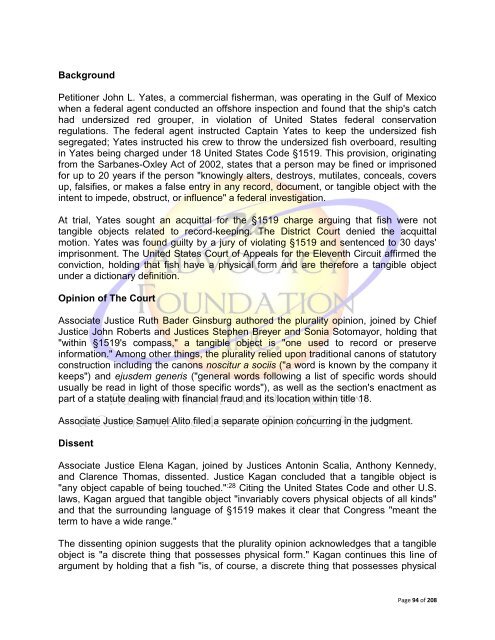The Sarbanes-Oxley Act of 2002
The Sarbanes-Oxley Act of 2002
The Sarbanes-Oxley Act of 2002
Create successful ePaper yourself
Turn your PDF publications into a flip-book with our unique Google optimized e-Paper software.
Background<br />
Petitioner John L. Yates, a commercial fisherman, was operating in the Gulf <strong>of</strong> Mexico<br />
when a federal agent conducted an <strong>of</strong>fshore inspection and found that the ship's catch<br />
had undersized red grouper, in violation <strong>of</strong> United States federal conservation<br />
regulations. <strong>The</strong> federal agent instructed Captain Yates to keep the undersized fish<br />
segregated; Yates instructed his crew to throw the undersized fish overboard, resulting<br />
in Yates being charged under 18 United States Code §1519. This provision, originating<br />
from the <strong>Sarbanes</strong>-<strong>Oxley</strong> <strong>Act</strong> <strong>of</strong> <strong>2002</strong>, states that a person may be fined or imprisoned<br />
for up to 20 years if the person "knowingly alters, destroys, mutilates, conceals, covers<br />
up, falsifies, or makes a false entry in any record, document, or tangible object with the<br />
intent to impede, obstruct, or influence" a federal investigation.<br />
At trial, Yates sought an acquittal for the §1519 charge arguing that fish were not<br />
tangible objects related to record-keeping. <strong>The</strong> District Court denied the acquittal<br />
motion. Yates was found guilty by a jury <strong>of</strong> violating §1519 and sentenced to 30 days'<br />
imprisonment. <strong>The</strong> United States Court <strong>of</strong> Appeals for the Eleventh Circuit affirmed the<br />
conviction, holding that fish have a physical form and are therefore a tangible object<br />
under a dictionary definition.<br />
Opinion <strong>of</strong> <strong>The</strong> Court<br />
Associate Justice Ruth Bader Ginsburg authored the plurality opinion, joined by Chief<br />
Justice John Roberts and Justices Stephen Breyer and Sonia Sotomayor, holding that<br />
"within §1519's compass," a tangible object is "one used to record or preserve<br />
information." Among other things, the plurality relied upon traditional canons <strong>of</strong> statutory<br />
construction including the canons noscitur a sociis ("a word is known by the company it<br />
keeps") and ejusdem generis ("general words following a list <strong>of</strong> specific words should<br />
usually be read in light <strong>of</strong> those specific words"), as well as the section's enactment as<br />
part <strong>of</strong> a statute dealing with financial fraud and its location within title 18.<br />
Associate Justice Samuel Alito filed a separate opinion concurring in the judgment.<br />
Dissent<br />
Associate Justice Elena Kagan, joined by Justices Antonin Scalia, Anthony Kennedy,<br />
and Clarence Thomas, dissented. Justice Kagan concluded that a tangible object is<br />
"any object capable <strong>of</strong> being touched." :28 Citing the United States Code and other U.S.<br />
laws, Kagan argued that tangible object "invariably covers physical objects <strong>of</strong> all kinds"<br />
and that the surrounding language <strong>of</strong> §1519 makes it clear that Congress "meant the<br />
term to have a wide range."<br />
<strong>The</strong> dissenting opinion suggests that the plurality opinion acknowledges that a tangible<br />
object is "a discrete thing that possesses physical form." Kagan continues this line <strong>of</strong><br />
argument by holding that a fish "is, <strong>of</strong> course, a discrete thing that possesses physical<br />
Page 94 <strong>of</strong> 208

















